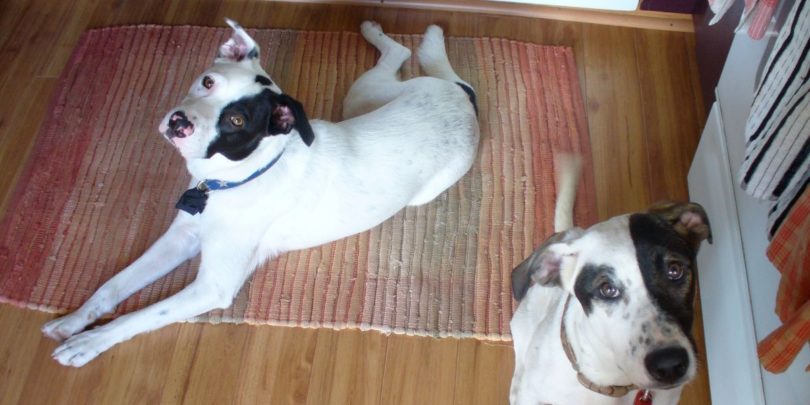1. Management is your best friend.
Management can be a long term solution to a behavior problem or a short term solution while you are training a new behavior response in that context. For example, you can manage your dog’s barking by leaving the blinds closed. You could do that forever OR you can do that for now while you train your dog to be quiet as people pass the house.
2. Train in context.
Dogs do not have the capability of generalizing a behavior from one context to the next. For example, just because you teach your dog to sit on verbal cue without any distractions does not mean they know to sit when people come to the door! Different contextual situation.
First, identify when you would like the dog to engage in a specific behavior. For example, maybe you need the dog to wait at the front door, at the curb on walks and before hopping out of the car. You would need to train that behavior in all situations in order to help the dog generalize this behavior to all contexts.
3. Train under emotional threshold.
It is not the right time to train your dog when they are feeling threatened, fearful or anxious about their environment. Dogs learn more efficiently (just like us) when they are under emotional threshold. As trainers, we need to set up the situation so that the dog is successful and they can process the learning we are asking them to.
That may include: crossing the street when oncoming people or dogs pass. It might mean changing environments to reduce stressful distractions. Or making providing more exercise and mental enrichment to reduce overall stress and anxiety.
4. Duration, Distance, Distraction!
When training a new behavior it’s important to make sure the environment is working with you and not against you!
- Duration = how long the dog can perform the behavior
- Distance = how far away are you from the dog OR how far away is the dog from the distraction
- Distraction = anything the dog finds exciting and could interrupt a behavior
When you are building a behavior, you must only work one “D” at a time. For example, if I am teaching my dog to come to me in the house (low levels of distraction) I can increase the distance between me and the dog. If I move that training game to the backyard and the distraction level increases (squirrels, scents, visual stimulation) then I must reduce the distance between myself and the dog.
5. Choose the right reinforcer.
In order for behavior to increase and continue, it must be reinforced. The laws of science! In that case, we must choose the right reinforcers for our dogs. Some of these reinforcers may include meals, treats, play, attention, toys and life rewards! Listen to your dog as he/she will tell you what THEY find reinforcing! Favorite treats include:
- Deli Meat, Sausage, Cheese
- Natural Balance or Red Barn Treat Rolls
- Stella and Chewy’s Freeze Dried Cakes
- Ziwi Peaks Air-Dried Dog Food
- The Real Meat Company Treats
- Lick-able Treats:
- Cream Cheese, Peanut Butter frozen/refrigerated in a small tupperware
- Meat based baby food (Gerber) from the jar
6. Warm Up.
Start off your training sessions by asking your dog an easy behavior that he/she knows well to get them invested in the training process. This is a win-win situation for both of you!
7. Take breaks.
When learning something new, we often need to take a break, stretch our legs, take a snooze and allow for our brains to process what we’re learning. Dogs are the same way! The break can be as little as 5 minutes of play in between training sessions or as long as a day to allow for the dog to let the learning sink in.
8. Keep your sessions short and positive.
When teaching something new we want to set up the environment so that the learner is successful and one way to do that is to keep the training sessions short – 10 to 15 minutes! That is a rough time frame as there are some dogs that need shorter time frames and others that could train for an hour – border collies, showing off! Just make sure that your dog is successful and that you are both having fun. If not, take a break and re-evaluate the situation before training again.
9. Increase difficulty in small increments.
When you first learn how to do a backhand in tennis, you do not practice it once on your local tennis court and then head to the US Open. There are a ton of small steps in between that help the learner perfect this skill. The same goes for dog training. We have to help them reach the final goal by generalizing the behavior.
- Come when called in the backyard
- Come when called in the front yard
- Come when called on leash 6 feet away
- Come when called on leash 10 feet away
- And so on…
10. Practice and track progress.
I understand that most people did not get a dog to become a dog trainer. They got a dog to experience companionship, friendship, go on adventures and have hair all over the house! Dog training techniques take time to learn for both the dog and the pet parent. You do not lose weight overnight after working with a personal trainer once. You do not get over your fear of commitment after one therapy session. And you do not resolve an injury after one physical therapy session. It takes practice, commitment and motivation to find a new way of doing things for both you AND your dog!

